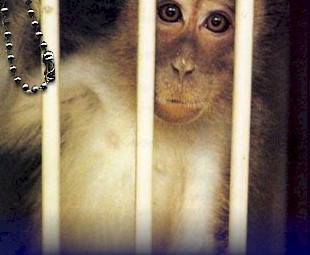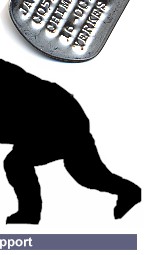






|
||||||||||||||||||||||||||||||||||||||||||||||||||||||||||||||||||||||||||||||||||||||||||||||||||||||||||||||||||||||||||||||||||||||||||||||||||||||||||||||||||||||||||||||||||||||||||||||||||||||||||||||||||||||||||||||||||||||||||||||||||||||||||||||||||||||||||||||||||||||||||||||||||||||||||||||||||||||||||||||||||||||||||||||||||||||||||||||||||||||||||
The Fate of cj0223
from the files of the Wisconsin Regional Primate Research
Center (WRPRC) cj0223 was a male Common Marmoset, Callithrax jacchus,
a species native to northeast Brazil. He was born on Oct. 16,
1991 and acquired by WRPRC from the now defunct Laboratory of
Experimental Medicine and Surgery in Primates (LEMSIP) on Nov.
4, 1992. He was killed at WRPRC on Sept. 21, 2001 having spent
all of his nearly ten years of life imprisoned at research labs.
At autopsy cj0223 had chronic kidney inflammation as well as
inflamed bowels from lymphocytic enteritis and intestinal amyloidosis
lesions associated with chronic wasting illness. It seems that
this latter condition is epidemic in the marmosets confined at
WRPRC. In the wild, marmosets include tree sap as an important
component of their diet (sap is probably vital for Common Marmosets),
a dietary requirement which research labs have difficulty providing.
This deficiency may account for the chronic digestive illness
rife among the marmosets held captive in our nation's labs. While at WRPRC, cj0223 suffered through a variety of research
experiments. Four months after his arrival there, the little fellow
was part of a study titled "Formation of Social Groups in
Marmosets." In the wild, marmosets have a chance to escape
from aggressive group members; caged monkeys do not. Shortly after
he entered the project, cj0223 sustained bite wounds on his forehead,
foot, ankle, fingers, forearm and elbow. Subsequently, he was a test subject in research investigating
"Hypothalamic Mechanisms Mediating Social Suppression of
Reproduction." For this a vivisector surgically implanted
a catheter in his internal jugular vein which required repeated
flushing and two re-suturings after the incision opened. He endured
the catheter for nine days. Two months later he was put in the
social group study again for seven months. In mid-1996, he was used in a project titled, "Clinical
Blood or Surgery" during which he endured several large blood
draws. It was during this time that the eye problems that would
plague him for the rest of his life were first observed. The condition
was treated repeatedly with antibiotics and steroids but ultimately
led to cataract surgery on both eyes and possible blindness before
he was killed. Despite his eye condition, for the next five years vivisectors
continued to use him in additional studies like "In Vitro
Bioassay for Luteinizing Hormone", "Absence of Estrogen-Depletion
Bone Loss in Marmosets", and, "Bone Mass and Aging in
Marmosets." Also, he continued to be used in the social group
study where he received yet another bite wound, this time to his
face and for numerous blood draws including one that was so massive
that he had to be treated with iron and fluid replacement therapy.
Between 1997 and 2000, he was placed in WRPRC's marmoset breeding
colony and sired 10 offspring - a joy had they been born in the
wild, but under the circumstances only continuing the legacy of
confinement and pain for another generation of marmosets. During his nearly nine years of confinement at WRPRC, cj0223
was subjected at least 39 blood draws and was given general anesthesia
(ketamine or saffan) 11 times either as part of research projects
(once for the removal of cerebrospinal fluid) or to treat illness.
Also, WRPRC's records indicate that cj0223 was moved to a different
cage at least 40 times inhibiting any chance of enjoying some
comfort from familiar surroundings. The final notation in cj0223's historical record on the date
of his death reads "… reluctant to prolong treatment
of aged animal with multiple physical abnormalities" Many medical historians and researchers continue to question
the scientific validity of biomedical research using animals.
All disease is a disruption of cellular and biochemical processes
which vary enough from species to species, even those that are
similar externally, so as to make extrapolation to the human condition
dangerously misleading. Furthermore, much of the research conducted
is repetitive and/or unnecessary except to provide income and
notoriety for vivisectors. Is knowledge about "Hypothalamic
Mechanisms Mediating Social Suppression of Reproduction"
so important that researchers feel justified in imprisoning and
harming primates to gain it? In addition, animal species routinely used in research have the
capacity to feel pain, to enjoy pleasure, to think and act purposefully,
and to prepare for future events. In short, they have degrees
of self-awareness and lives that are important to them beyond
any utilitarian purposes they may have for us. To incarcerate
them and subject them to painful research, even if such research
may afford some benefit to humans, is unethical and immoral. If
we are willing to subject innocent creatures to pain and agony
in and attempt to improve our health, are we worth the effort?
Rest in peace cj0223. This accounting of cj0223's life was written by Bob Tintle. Mr. Tintle wrote to WRPRC for cj0223's records and brought his story to light. The Primate Freedom Project is thankful that Mr. Tintle and other concerned citizens are gathering information about the primates imprisoned in the nation's labs and calling attention to their misery. Such stories underline the fact that suffering-filled lives are the norm within these institutions. Speak out. Your silence signals your acceptance.
Home Page | Our Mission | News |